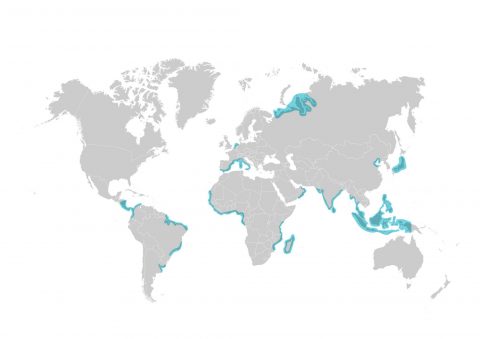
Coasts and Deltas
Mangroves, mudflats, saltmarshes and sea grasses in deltas and along the coast provide millions of people with a vital source of income and protect them from the ravages of storms and floods. Bridging the land and the sea, they are home to a large number of plants and animals. As such are the basis for safety and of a prosperous economy in both cities and rural areas. Deltas are complex environments, typically comprising different ecosystem types and land uses, with diverse stakeholder perspectives and interests.
We want to safeguard and restore coastal wetland ecosystems as essential features of resilient and productive coastal landscapes. We will achieve our goal by tailoring our work to the different contexts we typically encounter in our target areas. Sometimes all of these approaches may be employed within different zones of one large coastal landscape.
The value of coasts and deltas
As connectors between marine, freshwater and terrestrial ecosystems they serve as ecological corridors that provide breeding grounds for fish and other marine fauna, stopover sites for millions of migratory birds, and hunting and grazing grounds for visiting megafauna from sharks to tigers. They store large amounts of carbon in biomass and soils – typically more than equivalent areas of rainforests – and by regulating flows of water and sediment they contribute to building robust and diverse coastlines.
All this makes them important for humans too. As fishing grounds, shelters and places for aquaculture and recreation, they sustain hundreds of millions of livelihoods, many of them directly dependent on wetland services. Coastal wetlands provide vital protection from storms, floods and salt water intrusion and in some cases even sea level rise. With almost a quarter of the world’s population located on lowlands within 100 kilometres of the ocean, the risks that deterioration of coastal ecosystems pose in an era of climate change are increasing fast.
Threats and challenges
Coastal wetlands are being invaded, fragmented and degraded by economic developments such as infrastructure projects, ill-advised coastal protection schemes, sand mining, agriculture and aquaculture. As well as damaging ecosystems, such projects disturb sediment and water flows, causing cascading effects along hundreds of kilometres of coasts. A piecemeal approach to countering such threats is unlikely to work. But integrated planning at the scale necessary is hard, when jurisdiction in coastal and intertidal areas is often unclear, competing claims for land exist and capacities for cross-sectoral collaboration are lacking. Nonetheless, it is essential if we are to halt the slide to coastal insecurity and turn the tide towards maintenance and restoration of wetland resources.
Climate change, coupled with rising sea levels and ocean acidification, pose increasing challenges for coastal regions that include flooding, coastal erosion and saline invasion of underground freshwater reserves. Meanwhile, the ability of wetlands to maintain themselves by migrating inland is often thwarted by coastal defences and other infrastructure. Their further decline will release their carbon into the air. Such impacts remain insufficiently accounted for in coastal planning. To safeguard and restore coastal wetlands requires policymakers to fully appreciate the values they offer and the risks posed by their loss.
Enablers to scaling up the safeguarding and restoration of coasts and deltas
To inspire change, the establishment of global targets for restoration and enhanced management of coastal resources, plus strategic partnerships for enhanced management of the marine environment, such as the Global Mangrove Alliance, can provide momentum for public-private collaboration across sectors.
Momentum built among development banks, government agencies and engineering firms can promote combined green-grey coastal engineering approaches, in line with Building with Nature principles. Strengthening the recognition of coastal wetland values in climate policies and plans plays an important role in scaling up the safeguarding and restoration of coastal wetlands. For instance, incentivising companies and government agencies interested in the carbon values of wetlands, to upscale conservation.
Where we work

We work with some of the world’s most populous and vulnerable coastlines including Java, Indonesia; the Rufiji Delta, Tanzania; the Saloum Delta, Senegal; the Parané Delta, Argentina, the Tana delta, East Kalimantan, and the Mahanadi Delta.
Partnerships and platforms for change
- We work closely with the four other founding partners of the Global Mangrove Alliance: Conservation International, IUCN, The Nature Conservancy and WWF; as well as the broader membership base of the Alliance, including the Red Cross movement, Wildlife Conservation Society and the Zoological Society of London. We are actively exploring landscape scale mangrove recovery programmes with companies Permian Global, Boskalis and Greenchoice, with whom we have entered into partnership
- We are an active partner of the Ecoshape Building with Nature Consortium, in which we collaborate with water engineering companies, knowledge institutes and governments.
